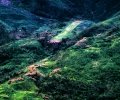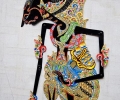KPC: the Afterlife Places
The KPC mine region might be similar to the places we will go after we die, according to Bible. Tanjung Bara is the heaven; Sangata Lama (Old Sangata) the hell; and Sangata Baru (New Sangata) the temporary shelter, where souls are waiting for God to make decision on their fate because their sins are about equal to their good deeds.
Tanjung Bara had clean air and water. The houses—standing on a hill facing the ocean—were luxurious: all fully air-conditioned, nicely trimmed green grass and neatly planted colorful flowers in the yards, and a car in the garage. The apartments had the same quality, only smaller. Everybody could swim in the Olympic-size swimming pool in the community center, free of charge. Only if we wanted to drink from the bar by the pool, we had to pay. We could play golf too—its court by the sea and bordered by rainforest inland—was spectacular, but we had to be the member of the club, exclusive for the VIPs, to play there. It was OK, Tanjung Bara had other fine sport facilities such as football field (real one, not American body charge) or squash court. The best was its marina; it is well equipped for fast boating, sailing, diving, snorkeling, and fishing.
I loved lunch and dinner in Tanjung Bara. The food was delicious, abundant, and . . . free. My plate looked like Mount Bromo plateau, Western food on the right side, Indonesian food on the left. However, I always felt guilty at the end of the meal: only a half to two third of it passed into my tummy. Still, I continued to the desert bar afterward. Cakes, pudding, and, especially, ice cream were irresistible. I deserved for this heavenly meal after having instant noodle and watercress every day for two years in Asmat.
According to Bible, Saint Peter passes good people only into heaven. I believe going to church, at least once a week, is one of the criteria to enter heaven. St. Peter might have removed this criterion because very few residents of Tanjung Bara went to church, especially the bule, a half of the population of Tanjung Bara. He might also have taken out adultery from the list; a number of residents kept a mistress in their house or apartment.
There was a gate and rainforest separating Tanjung Bara from the other two places. The residents of these places—Old Sangata: 75% of the population of the region; New Sangata: 20%—were not allowed to enter Tanjung Bara unless they were invited or accompanied by a Tanjung Bara resident. In contrast, the Tanjung Bara residents freely entered both Sangatas. In fact, these heaven inhabitants, including the bules, regularly ventured to Old Sangata visiting prostitute complex.
The hospital was in New Sangata. If I was not on-call, I slept in the Heaven Tanjung Bara but still had to go to New Sangata every morning. I enjoy the drive; the road was lined with dense big trees. Sometimes I saw monkeys or gibbons because the road cut the tropical rainforest. However, the drive was no fun at all if I drove behind a truck carrying coal. The visibility was only two meters ahead. If we opened the windows, our skin would be covered with a layer of black dust. Just imagine, how many of them travelled into our lungs.
Respiratory diseases—lungs and upper tract—are the dominant illnesses among the residents of Sangata Baru and coal workers. When the wind blew hard from the mining sites—less than five kilometer from the center of the town—we had to cover our face. The inhabitants just accepted this hazardous environment. Except for the heavy air pollution, New Sangata was a decent place to live in for lower staff and their families. The housing and community facilities, although not luxurious, were good. But most of coal workers and other non-staff employees did not live in New Sangata.
KPC and its contracting companies paid their employees ‘well’ (above minimum level of the national standard) but they did not give any housing allowance to the non-staff employees—around 60% of the total. As most of them were not locals, they had to allocate some of their salary for paying a simple room—for bachelors—or house—for those who brought their families—in Old Sangata.
The boarding or rent houses lined the Sangata River. Most of the owners were either Bugis or Makasar, the people from South Sulawesi. The lease was not cheap considering the lack of hygiene and sanitation. The bathrooms and toilets were built over the river. During the evening, people could hear the splash of their feces diving into the river. They would not move far because the river was full of garbage. We could smell them from inside the houses.
Most of the bachelors—either real or temporary—had to allocate some money for their biological (or social?) need. Luckily, they did not need go far. Old Sangata had hundreds of prostitutes to fulfill their need—a common phenomenon in any mining sites in the world, I believe. For this ‘normal’ activity, they had to reduce more their income for buying medicine; sexually transmitted diseases were other common diseases among male coal workers.
I could understand that visiting prostitute was essential to keep the single coal workers sane. The work on rotating schedule—typically 3-day evening shift, 3-day day shift, and one day off—was very tough. The mine sites were hot, dusty, and noisy; the work was monotonous, doing the same thing over and over.
My workplace was not as bad as theirs—in fact comfortable because it was air-conditioned. Nevertheless, the monotony was not much different, specifically in treating the outpatients. As the companies paid, many patients—wives the majority—came for trivial symptoms; mild anti-anxieties—Valium is one of them—often worked well for them in the first few weeks. In-patients were more interesting because the diagnostic facilities were excellent. I often went to the laboratory to do the tests by myself: blood, pus, skin scrap, or other specimens from the bodies of my patients. Sometimes the results were surprising, such as Trichomonas vaginalis (a single-cell parasite) found in the mouth swab of a male patient—normally only found in the specimen from female patients.





